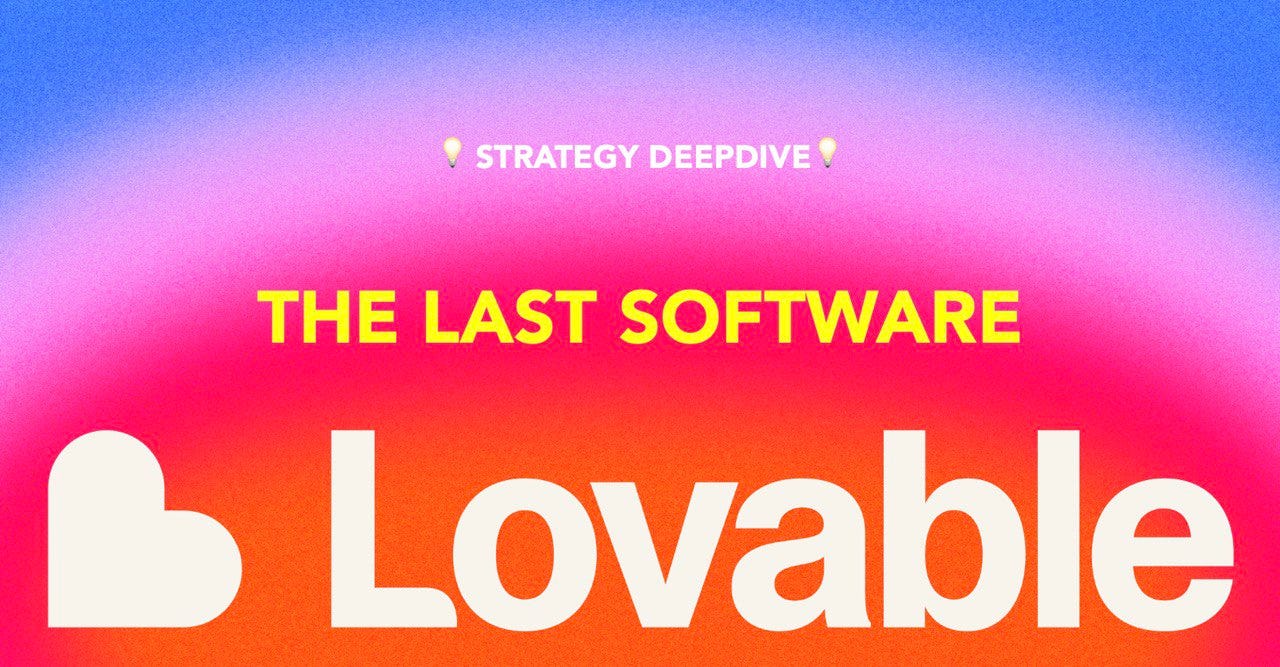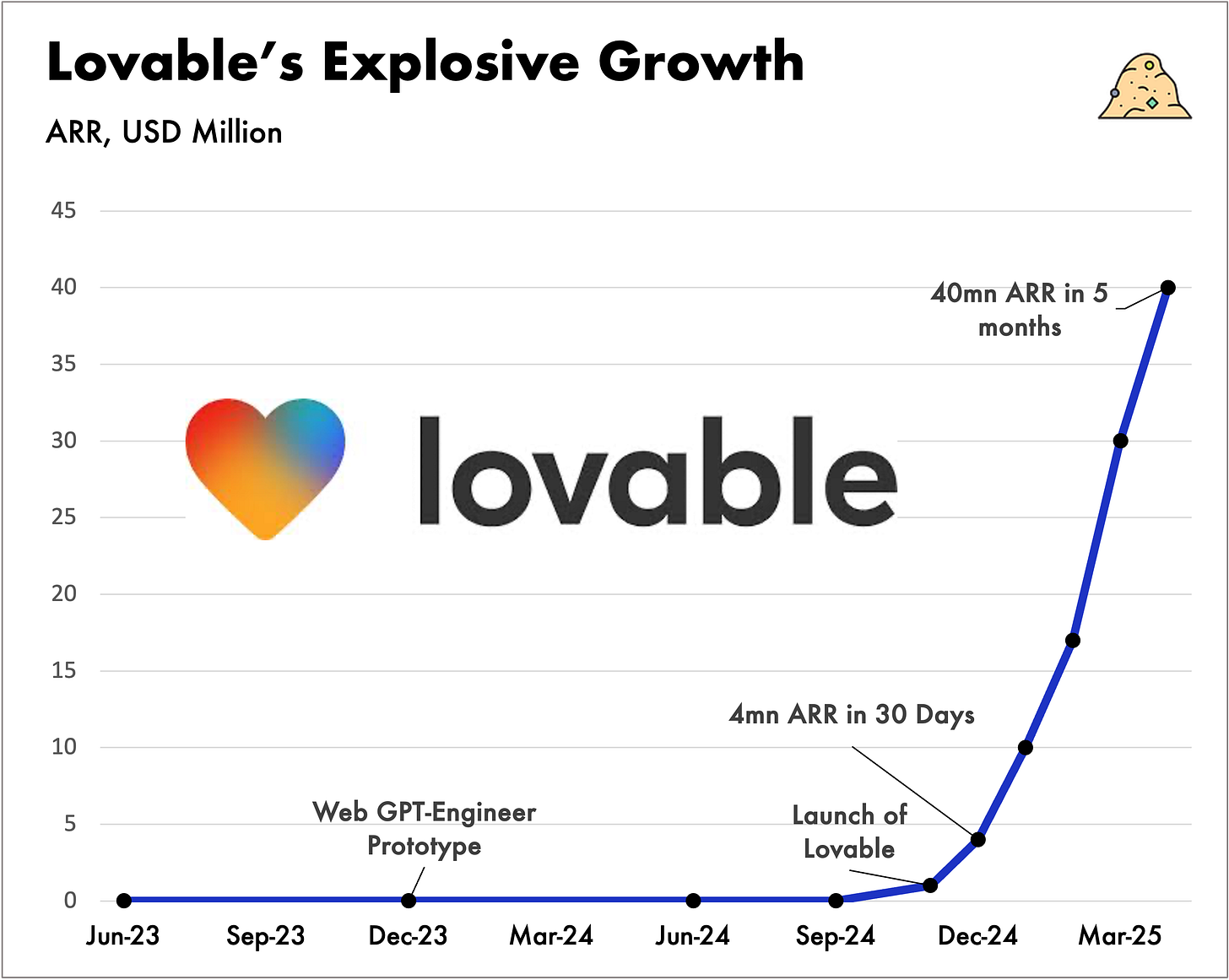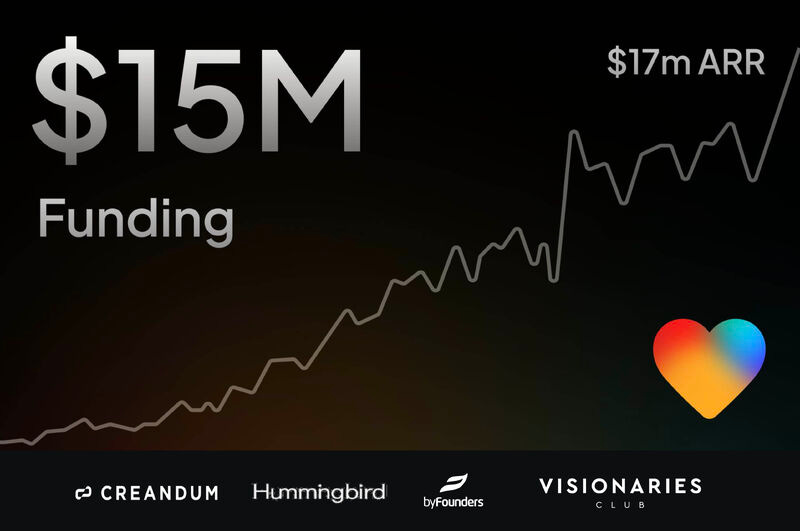Lovable: Everyone is a Builder
The Last Software Anyone Has To Write.
💡 TLDR: Key summary about Lovable you should know:
$18MN ARR in 3 Months: Lovable rocketed to $18mn ARR within 90 days of launch, with ~30k paying customers, likely the fastest ascent in European tech history. A tiny team (15 people) achieved $1M ARR per employee, shattering SaaS benchmarks.
Open-Source Launchpad: Lovable began as GPT-Engineer, a free Command Line Interface (CLI) tool that amassed 20k+ GitHub stars practically overnight. This gave Lovable an army of early adopters and 27k waitlist signups before launch, seeding its growth with zero marketing spend.
Product-Market Fit via “Reliability Unlock”: After a year of iteration, Lovable’s AI agent finally stopped getting stuck and could handle large codebases reliably. This breakthrough transformed Lovable into a must-share product, an AI that actually ships working apps.
Best in class customer retention: Lovable boasts retention that is higher than even ChatGPT, thanks to an obsessive focus on user experience. Satisfied users became evangelists, sharing thousands of AI-built apps and driving a viral growth loop.
Community Flywheel: Lovable engineered distribution with a build-in-public playbook: A “Launched” showcase let users publish and remix AI-generated apps, gamifying sharing via contests. Partnerships with dev darlings (Supabase, Replicate) and #1 launches on Product Hunt & Hacker News further fueled awareness. All with only ~$2M spent to date.
Funding and Trajectory: After a €6.8M pre-seed in Oct 2024, Lovable raised €14.3M ($15M) pre-Series A in Feb 2025. By May 2025, over 500,000 users had used the platform. A full Series A is likely on the horizon given Lovable’s rapid revenue and user growth.What if anyone could hire a genius software engineer on demand? Lovable is delivering on that promise. In just months, this AI-powered “full-stack engineer” went from a GitHub experiment to Europe’s fastest-growing startup, reaching an crazy $40mn in ARR within 5 months of going live.
From GPT-Engineer to Lovable
The roots of Lovable trace back to mid‑2023 when Anton Osika, then CTO of a Y‑Combinator startup and former CERN researcher, open‑sources a weekend project he calls GPT‑Engineer, a Command Line Interface (“CLI”) that can spin up an entire code‑base from a single prompt. Within weeks the repo explodes past 20,000 GitHub stars and “hundreds of thousands” of tinkerers, signalling an unmet appetite for AI that does more than autocomplete snippets.
Osika teams up with fellow Swede Fabian Hedin, who previously sold a high‑school startup, to transform the proof‑of‑concept into a product anyone, coder or not, can wield.
This open-source triumph gave Osika and Hedin instant credibility and a passionate community. By late 2023, with 27k people on the waitlist asking for more, the Swedish duo decided to take GPT-Engineer to the next level, with had audacious goal, to make software creation accessible to the 99% of people who can’t code.
They set out to build a friendlier product on top of the GPT-Engineer engine so that even non-developers could use it. The first prototype, GPTEngineer.app, quietly launched in Dec 2023 , but early versions were still rough. Over the next year, the team kept iterating through trial and error.
A turning point came by mid-2024. Lovable’s team discovered how to stop the AI agent from getting “stuck” on key tasks and enabled it to handle larger, more complex codebases. They prioritized must-have flows such as adding login, persisting data and wiring Stripe payments.
This reliability unlock, ensuring the AI could successfully plan, code, and debug full apps was crucial. With a far more capable product in hand, the founders decided it was time for a grand debut. Just two days before a November 2024 launch, they rebranded GPT-Engineer as “Lovable” , reflecting a broader vision of “software that creates software.” The relaunch was perfectly timed: Lovable’s public beta exploded out of the gate.
On November 21, 2024, Lovable’s new web app went live. It promptly hit #1 on Product Hunt (with a 5 star rating) and the front page of Hacker News. The open-source “halo” effect was evident: thousands of early fans mobilized to try it and spread the word. In its first four weeks, Lovable’s AI engineer helped users build enough projects to reach $4M in ARR. By two months in, that figure hit $10M ARR. The little side-project had officially become Europe’s fastest-growing startup ever.
An AI Full-Stack Engineer That Actually Works
Lovable calls itself “the last piece of software”. An AI-powered platform that turns plain English descriptions into live applications. In practice, it gives users a chat interface to a tireless AI engineer. It is a magical experience where you simply describe your idea or features, and Lovable’s agent springs into action: scoping the project, writing code for front-end, back-end, and database, running tests, and deploying the result. Things that takes months and thousands just a couple years ago.
Under the hood, Lovable orchestrates multiple AI models and tools to achieve this autonomy. It uses advanced reasoning to create, debug, and maintain the codebase in a loop. If it encounters an error or a requirement gap, it can attempt a fix or ask the user for clarification, much like a human engineer would. This agent approach was honed from the GPT-Engineer CLI days and is Lovable’s secret sauce, enabling it to deliver production-ready software, not just snippets.
“We’ve seen hundreds of commercial apps built on the platform, at least 25,000 apps a day,” - Anton Osika
To make AI development approachable, Lovable provides a visual WYSIWAI editor (“what you see is what AI imagined”). After the AI generates your app, you can toggle into a Figma-like Visual Edit mode to tweak the UI or content directly on the page, without touching code.
This allows non-programmers to fine-tune layouts, colors, text, etc., and then save changes back to the code seamlessly. In effect, Lovable combines the speed of AI generation with the control of a traditional editor. This addresses the pain point of the difficulty of altering AI-produced code faced with other code assistants. It’s “no-code meets pro-code”: users get a smooth visual experience, but behind the scenes it’s editing code.
Finally, Lovable streamlines the deployment process. Every project comes with one-click cloud deployment, the platform integrates with popular hosting services like Netlify/Vercel and database/auth providers (Supabase, Clerk) so that a user’s app can go live instantly. In practice, when the AI finishes building your app, you can publish it to a URL with a button click (or connect your own domain). Lovable handles the DevOps drudgery: setting up repositories, deploying updates on each change, and monitoring uptime via its dashboard. This way, a non-technical creator can go from idea to a shareable, running product in an evening without tickering with local environment and manual server setup.
Hacking Growth with Community and Content
Lovable’s early growth was orchestrated through a clever build-in-public playbook that the team executed relentlessly. A cornerstone of their strategy was turning their enthusiastic user community into a self-sustaining marketing engine. One of Lovable’s inventions is “Launched”, a community app showcase at launched.lovable.dev.
Users who built something with the AI can post their app to this gallery and earn upvotes. Each week, the top-ranked apps win free usage credits, spurring friendly competition. The effects of Launched have been powerful: it gamifies sharing (hundreds of apps submitted per week), provides social proof to newcomers browsing the gallery, and even drives new users because every shared app includes an “Edit with Lovable” button, inviting others to remix it and sign up. This community content created a viral loop: users build → share → new users join → build more.
Beyond the showcase, Lovable invested heavily in fostering its community. The team runs online hackathons by partnering with VC firms like a16z and Northzone to host them, highlighting user success stories in their blog and newsletter. They also set up official Discord and Reddit channels where users swap tips and prompt ideas. All of this made early adopters feel like part of the journey. “Users became our voluntary salesforce,” Osika has said in interviews and it shows in the numbers. Thanks to word-of-mouth on X and LinkedIn, Lovable grew to 30k customers almost only through organic word of mouth.
Content marketing and strategic partnerships formed another key growth engine. Lovable’s demos are inherently shareable, watching an AI build an app in 30 seconds feels like magic, so the team leaned into short video content. They posted snappy build videos on TikTok, Twitter, and YouTube that went viral among tech circles.
Anton Osika became a hands-on evangelist, regularly sharing behind-the-scenes updates, metrics milestones, and even memes on LinkedIn and X. His informal, authentic style stood out in a space normally dominated by polished product shots. This authenticity helped him amass a following and kept Lovable constantly in the social media discourse.
Lovable also piggybacked on larger platforms and communities. They forged integration partnerships with popular developer tools. For example, doing joint webinars with Supabase (database) and Replicate (AI model hosting) to show how Lovable plugs into those services. Each collaboration cross-pollinated user bases (“Supabase’s community discovered Lovable, and vice versa”), adding credibility by association. The Lovable team even joined an official Andreessen Horowitz AI showcase alongside bigger-name startups, boosting their visibility among tech influencers. And of course, the Product Hunt launch was executed flawlessly: the team rallied their open-source fans to upvote en masse, yielding a #1 Product of the Day and a flood of sign-ups. In short, Lovable created a flywheel where community, content, and product excellence reinforced each other. A textbook example of scrappy, modern go-to-market execution.
Hyper-Growth
The numbers behind Lovable’s rise are eye-popping. Three months from its public launch, Lovable reached $18M in ARR, with 30,000 paying customers on board. For context, it took Slack about 3 years to hit similar revenue. Lovable did it in a single quarter, without a sales team.
This translates to roughly $1M in ARR per employee, given the team had just 15–18 people at the time, literally off the charts for a SaaS startup. For a software company with $20–50M ARR, a ‘great’ ARR/employee is ~$275k. Lovable’s ~$1M is wild. This efficiency is a testament to the product-led growth and the leverage of having AI handle much of the heavy lifting.
User adoption has been equally impressive. By Feb 2025, over 500,000 users (free and paid) had signed up to try Lovable’s AI builder. Many churned after tinkering, but the core paying base kept growing and using the product. Lovable reported that by month three, users were collectively creating 25,000+ new apps per day on the platform. This hints at strong engagement and that people are incorporating Lovable into real projects and workflows.
Another metric pointing to product-market fit: Lovable achieved 85% 30-day retention of users during its early growth, surpassing even OpenAI’s ChatGPT retention. In other words, the majority of users who built something with Lovable once were coming back to build more, a sign of genuine value, not just hype.
On the funding front, Lovable has been strategic. The founders raised a €6.8M pre-seed (led by Hummingbird and byFounders) in late 2023 to assemble a small team of elite engineers and cover initial compute costs. Notably, they held off on a bigger raise until they had clear traction. Only after hitting ~$10M ARR did Lovable announce a $15M pre-Series A in February 2025.
Creandum led the round, with prominent angels like Charlie Songhurst (ex-Microsoft), Adam D’Angelo (Quora), and Thomas Wolf (Hugging Face) joining. The capital is earmarked to expand integrations (e.g. deeper ties into tools like GitHub, Supabase) and scale infrastructure for the surging user base. Impressively, Lovable had only spent about $2M of its pre-seed money by the time of this raise , showing high capital efficiency. With fresh funds, the team is likely growing beyond 18 people, but still pre-Series A, they maintain a lean, builder-heavy roster, about half the team are engineers, and most others are ex-founders or high-agency operators. This headcount discipline has helped Lovable set a new bar for ARR per employee, and gives them a long runway to keep executing at lightning speed.
Lovable and the AI Coding Wars
Lovable operates at the intersection of no-code tools and AI coding assistants, carving out a unique position. It’s useful to map the landscape of “AI coders” to see where Lovable stands. On one axis, consider the target user: professional developers vs. non-programmers. On another axis, consider the AI’s role: assisting a human vs. autonomously building. In Lovable’s case, the target user is the non-programmer (or any builder without deep coding skills), and the AI’s role is agentic and autonomous, making it a distinct offering in the market.
Direct competitors (AI app builders): A few startups are pursuing a similar vision of one-click app creation. Bolt.new is one notable competitor, an AI-powered app builder that also generates full-stack code from prompts. Like Lovable, Bolt can scaffold entire web apps and deploy them, though it has stayed more focused on developers as the user (it pitches itself as a way for devs to speed up building standard apps). So far, no competitor in this category has matched Lovable’s momentum or reliability, but the space is young. However, we’re likely to see more challengers given the massive TAM (virtually every knowledge worker with an idea could be a customer).
Adjacent competitors (AI coding assistants): On the developer-focused side, tools like Replit, Cursor, and Windsurf (formerly Codeium) are tackling parts of this problem. These products integrate AI into coding environments to help engineers code faster. For example, Replit’s Ghostwriter can autocomplete code and even generate entire projects from a prompt, but it operates within a developer IDE and assumes the user can refine the code. Cursor is an AI-enhanced code editor that uses an agent to manage your files and implement requests (similar underlying tech to Lovable, but aimed at programmers working in Python/TypeScript projects). Windsurf/Codeium has introduced an “AI agent” in its IDE that can run build commands and fix errors automatically, again oriented to coders. These tools live in the world of software professionals, they can supercharge productivity, but they are not turnkey app creators for a non-coder. As TechCrunch aptly noted, platforms like Cursor and Copilot “are mostly confined to a world of trained engineers,” whereas Lovable opened up app-making to anyone.
Big tech and incumbents: The specter of competition from the giants looms as well. OpenAI’s own Codex model (and GitHub Copilot powered by it) provides the core AI brains for many of these tools. So far OpenAI hasn’t rolled out an end-user product that builds apps from scratch, instead they supply the API (e.g. GPT-4.1) that Lovable runs on. Microsoft (which backs OpenAI and GitHub) has integrated Copilot deeply into Visual Studio and even into Power Platform for low-code scenarios. We may soon see an offering that tries to do what Lovable does (for instance, one could imagine ChatGPT integrating a “build me an app” plugin or Microsoft releasing a Copilot Studio for non-programmers). For now, Lovable’s head start and focus give it an edge: it’s a standalone, platform-agnostic solution laser-focused on AI app generation, while the big players are either enablers (OpenAI) or tied to their ecosystems (Microsoft’s copilot in Azure/Office).
Lovable’s edge: Speed and focus have been critical. By the time incumbents or well-funded startups noticed this opportunity, Lovable had already accumulated a 500k-strong user base and, crucially, a dataset/feedback loop from tens of thousands of real app builds. The reliability of its agent is a differentiator frequently cited by users, “Lovable is the best way to get something that actually works,” Osika argues, contrasting it with code assistants that often leave users with half-baked output. Moreover, Lovable’s community-driven moat (templates, showcase, active discourse) means it’s not just an AI model you can copy, it’s a network of builders and shared solutions. In effect, Lovable is attempting to build a network effect: the more people build and share apps on the platform, the more value new users get (via examples, templates, community help). This could prove a lasting advantage against tech giants, who have scale but not that grassroots developer-love. However, Lovable will need to keep innovating aggressively to maintain its edge, as the AI coding landscape is evolving daily.
Risks and Challenges
Despite its sensational start, Lovable faces a set of significant risks moving forward:
Sky-High Compute Costs: Generating full applications with AI agents is resource-intensive. By Osika’s own admission, Lovable likely has “the biggest spend on LLMs among startups in Europe” at this point (reflecting huge usage). Running GPT-4, Claude, and other models for thousands of users could burn cash quickly, especially if users on fixed monthly plans heavily utilize the service. The company’s gross margins may suffer if AI API costs don’t come down. In the long term, Lovable might need to develop its own optimized models or inference infrastructure to rein in costs, or lean in more on usage-based pricing to balance heavy users.
Code Quality and Liability: While Lovable strives for reliable outputs, AI-generated code can still introduce bugs or security vulnerabilities. If a Lovable-built app fails catastrophically or gets breached, who is responsible? The user or the platform? There’s also intellectual property risk: the AI might inadvertently produce code snippets that resemble licensed code, raising legal questions. Lovable will need to continuously validate and sandbox generated code. They’ve partially addressed this by open-sourcing the underlying engine (creating transparency) and allowing users to own the code (the user’s repo), but as usage scales, quality control will be an ongoing challenge. Enterprise customers in particular will demand strong assurances on security and compliance.
Incumbent Bundling and Competition: The flip side of being a pioneer in AI app-generation is drawing attention from industry giants. It’s easy to imagine players like Microsoft, Amazon, or Google bundling similar AI builders into their cloud platforms or no-code tools. For instance, Amazon could integrate a “GPT app builder” into AWS for its customers. If such offerings come free with a larger service, Lovable might face pressure to differentiate. Additionally, traditional low-code/no-code platforms (e.g. Webflow, Bubble) are starting to add generative AI features – they already have large user bases and could quickly catch up on the AI front. Lovable must move fast to establish an ecosystem (and maybe forge partnerships with the big clouds rather than compete head-on).
Sustainability of Hype: Hyper-growth can be a double-edged sword. Lovable’s astonishing early metrics set sky-high expectations. If ARR plateaus after the initial rush or early adopters churn out once the novelty wears off, the narrative could quickly shift. The company will need to move beyond the tech enthusiast niche into mainstream or enterprise use-cases to sustain growth. That involves refining the product (for even non-techier users), providing support/education, and perhaps curating successful use cases in specific verticals. Essentially, Lovable must prove it’s not just riding a hype wave but is a durable business. Maintaining its developer community goodwill while also courting enterprise clients will be a balancing act.
Next Act: What’s Ahead for Lovable
As of May 2025, Lovable stands at an inflection point. Flush with new funding and a record-setting launch behind it, the startup is charting its next moves to solidify its lead and expand its platform:
Enterprise & Teams Focus: An obvious next step is building out an enterprise-grade offering. Large companies may want to use Lovable’s AI internally, but will need features like on-prem or VPC deployment, single sign-on (SSO), audit logs, and the ability to restrict the AI to proprietary data. Lovable has already started an Enterprise tier with options to “opt out of data training” and dedicated support. We can expect a full enterprise SDK or API that lets development teams integrate Lovable’s engine into their own IDEs and workflows. This could open a new revenue stream (selling to IT departments or SaaS companies) and make Lovable more defensible by deeply embedding it in organizations.
Marketplace & Ecosystem: With thousands of apps and components being generated, Lovable may create a marketplace for templates, plugins, and AI extensions. Imagine new users being able to start from a community-contributed template (an e-commerce app, a CRM system, etc) instead of from scratch. In fact, the Launched showcase and prompt library are early signs of this. A formal marketplace could let creators sell polished templates or custom add-on modules (for example, a plug-in that adds a Stripe payments integration or a specific machine learning microservice) to others. This would further drive the flywheel: top community builders can monetize their expertise, and new users get faster time-to-value. It also positions Lovable as not just a tool but a platform others build on, increasing lock-in and network effects.
Continued Product Innovation: On the product roadmap, the team is likely tackling even bigger challenges: multi-modal inputs (e.g. generating apps from a hand-drawn sketch or from a competitor’s website URL), more complex application types (mobile apps, not just web; perhaps desktop software), and deeper customization for advanced users. The core AI model loop will also improve with data, every failed generation or user edit is feedback to make the next output better. There’s talk in AI circles about fine-tuning models for “software agent” tasks; Lovable could train its own model or a GPT-4 fine-tune on the trove of successful app builds it has, further improving reliability and speed. We might also see AI pair-programming features within Lovable, eg the AI suggesting improvements continuously as a user manually edits code – to cater to semi-technical users.
Long-Term Defensibility: To succeed in the long run, Lovable will need to cement advantages that competitors can’t easily copy. One such advantage is data, Lovable is amassing a unique dataset of prompt-to-app transformations and user feedback on those apps. If they leverage this to continuously fine-tune their AI, they could develop a proprietary model that outperforms general models for coding tasks. Another moat is the community and brand: Lovable has become synonymous with AI app-building, especially after the virality and media coverage. That mindshare, combined with the active community and content machine, is hard to replicate. Finally, Lovable could cultivate an ecosystem lock-in: if businesses start relying on Lovable for critical internal tools (and perhaps build custom integrations around it), switching to a competitor or DIY solution becomes non-trivial. In summary, the next act for Lovable is about evolving from a lightning-in-a-bottle startup into a sustainable platform – extending its lead in technology, broadening its user base (while keeping early adopters happy), and navigating the inevitable challenges that come with rewriting the software development playbook.











